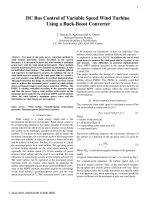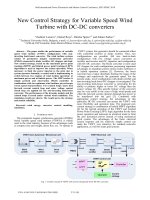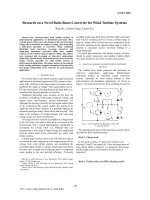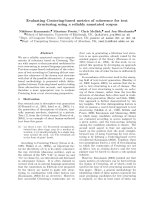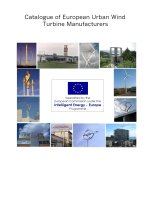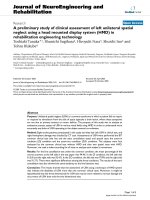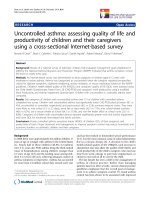DC bus control of variable speed wind turbine using a buck boost converter
Bạn đang xem bản rút gọn của tài liệu. Xem và tải ngay bản đầy đủ của tài liệu tại đây (164.08 KB, 5 trang )
1
Abstract— For most of the peak power extraction methods in
wind turbine generation system described in the current
literature, it is necessary to know the wind turbine’s maximum
power curve and the wind speed measurement. These methods
used the maximum power curve obtained via simulations or tests
for individual wind turbines. This makes these methods difficult
and expensive to implement in practice. In addition, the use of
wind speed sensor to measure the wind speed adds to a system a
cost and presents some difficulties in practical implementation.
This paper describes the design of a buck-boost converter circuit
used to achieve the maximum power control of wind turbine
driven permanent magnet synchronous generator (PMSG). The
PMSG is suitably controlled according to the generator speed
and thus the power from a wind turbine settles down on the
maximum power point by the proposed MPPT control method,
where the wind turbine’s maximum power curve and the
information on wind velocity are not required.
Index Terms— Wind turbine, Variable-Speed, synchronous
generator, Maximum power, Buck-boost converter
I. I
NTRODUCTION
Wind energy is a clean energy which had a fast
development for the two last decades. Wind energy seems to
be an interesting alternative that makes possible to control the
energy injected into the network and to produce not polluting
fuel usable in the buildings, and thus to diversify the energy
markets. To be used on wide applications and to satisfy the
economic constraints, the conversion chain of this energy must
be robust and reliable. It must also present a better efficiency
and be realized at low cost. For that, it is necessary to extract
the maximum power from wind turbine. The operating power
of wind turbine depends on the wind speed intensity and
especially the turbine speed [1]. If the transfer of power
between wind turbine and the load is not optimal, the total
efficiency of wind energy system will be largely affected [2].
The wind turbine can be operated at the maximum power
operating point for various wind speeds by adjusting the
turbine speed optimally [3],[4]. In previously published works,
most of the MPPT methods described require the knowledge
of the wind turbine’s maximum power curve and the wind
speed measurement [5-7]. The maximum power curve needs
to be obtained via simulations or tests for individual wind
turbines, which makes these methods difficult and expensive
to implement in practice [8]-[9].
In addition, the use of wind
speed sensor to measure the wind speed adds to a system a cost
and presents some difficulties in practical implementation.
These MPPT methods described in the current literature are
too expensive compared with generator whose rated capacity
is small [10]
This paper describes the design of a buck-boost converter
circuit used to achieve the maximum power control of wind
turbine driven PMSG. The PMSG is suitably controlled
according to the generator speed and thus the power from a
wind turbine settles down on the maximum power point by the
proposed MPPT control method, where the wind turbine’s
maximum power curve and the information on wind velocity
are not required.
II. W
IND TURBINE
C
HARACTERISTICS
The conversion from wind speed to mechanical power (Pm)
can be described in steady state by [11]
3
( ) *0.647 * *Pm Cp A v
λ
=
(1)
Where
r = radius of the rotor [m]
ρ = air density [Kgm-3]
A = wind turbine rotor swept area [m
2
]
v = wind speed [m/s]
The power coefficient expresses the conversion efficiency of
the turbine as a function of the tip-speed ratio (λ) given by
[12]:
.
m
r
v
λ
Ω
=
(2)
Where
m
Ω
is mechanical angular velocity of the generator
(rad/s).
A typical relationship between Cp and
λ
is shown in Fig.1.
For constant-speed operation, the turbine speed (
m
Ω
) is
forced to remain constant. Thus, as the wind speed changes,
the tip speed ratio and the power coefficient will vary. Since
the Cp characteristic has a single maximum at a specific value
of it is apparent that, when operating at a constant speed, the
power coefficient will be maximum at only one wind speed.
DC Bus Control of Variable Speed Wind Turbine
Using a Buck-Boost Converter
T. Tafticht, K. Agbossou and A. Chériti
Hydrogen Research Institute
Université du Québec à Trois-Rivières,
C.P. 500, Trois-Rivières, (QC), G9A 5H7, Canada.
1-4244-0493-2/06/$20.00 ©2006 IEEE.
2
Unlike constant-speed control, a variable-speed control can
adjust the speed of the turbine as the wind speed changes, so
as to operate at the peak of the Cp curve. This will maximize
the power generated for a particular wind speed, as it shown
on Fig.2. In this figure, curves for the power generated at
various wind speeds are given. The curve connecting the
peaks of these curves will generate the maximum power for a
given wind speed and follow the path for maximum Cp
operation
.
III. C
ONVERTER DESIGN
The figure 3 gives the schematic diagram of the stand-alone
wind energy system under consideration. A three-phase
PMSG is connected to a DC battery bank via a rectifier. The
DC/DC converter is connected with rectifier circuits like fig.3.
It is assumed that the power generated from the generator is
converted into DC power through diode bridge rectifier
circuits with a unity power factor and the load current is
continuous [13]
3
tdcdc
PVIVI==
(3)
Where, V
dc
, I
dc
are DC side voltage and current, respectively.
The mean value of DC voltage is shown like the following.
6
max
6
3
cos
dc LL
VVd
π
π
θθ
π
−
=
∫
(4)
where V
LLmax
is the maximum value of line-to-line voltage .
max
3
dc LL
VV
π
=
(5)
From this, the relationship between V
dc
, and line to line
voltage V
LL
and phase voltage V, is shown as following,
3
2
dc LL
VV
π
=
(6)
3
6
dc
VV
π
=
(7)
From (3) and (7), the equation of I
dc
and I, concisely
expressed is obtained.
6
dc
II
π
=
(8)
The PMSG is connected with rectifier circuits like fig.4. It is
assumed that the AC power generated from the generator is
converted into DC power through diode bridge rectifier
circuits. In continuous conduction mode, the buck-boost
converter assumes two states per switching cycle. The ON
State is when IGBT is ON and diode is OFF. The OFF State is
when IGBT is OFF and diode is ON. A simple linear circuit
can represent each of the two states where the switches in the
circuit are replaced by their equivalent circuit during each
state. The circuit diagram for each of the two states are shown
in Fig.4-a and Fig.4-b. If the output load current is reduced
below the critical current level, the inductor current will be
zero for a portion of the switching cycle. In a buck-boost
power stage, if the inductor current attempts to fall below
zero, it just stops at zero and remains there until the beginning
of the next switching cycle. This operating mode is called
discontinuous conduction mode (see Fig.4-c). A power stage
operating in discontinuous conduction mode has three unique
states during each switching cycle as opposed to two states for
continuous conduction mode. The inductor current condition
where the power stage is at the boundary between continuous
and discontinuous mode is shown in Figure 4. This is where
the inductor current just falls to zero and the next switching
cycle begins immediately after the current reaches zero.
In continuous conduction mode, the ratio between the output
and input voltages turns out to be:
1
bat
dc
V
V
α
α
=
−
(10)
Where
α
is the duty cycle and V
bat
is the battery voltage.
Fig. 2. Typical wind power versus turbine rotor speed
Fig. 1. Power coefficient versus tip-speed ratio.
Fig.3 : Connection diode rectifier circuits to the generator.
3
If the converter’s losses are negligible, its power transfer
equation becomes:
2
2
bat
dc
ch dc
V
V
P
RR
==
(11)
Which R
ch
represent the electric load.
and that gives:
2
1
dc ch
RR
α
α
−
⎛⎞
=
⎜⎟
⎝⎠
(12)
From (7),(8) and (11), the following equation is obtained.
2
18
dc
dc
dc
V
V
R
II
π
==
(13)
Resistance value Rg, per phase of rectifier circuits is shown
like the following by generator terminal voltage V, and line
current I,
g
V
R
I
=
(14)
The following equation is obtained, when (14) is substituted in
(13).
2
18
gdc
RR
π
=
(15)
From (21) and (24), the following equation is obtained.
2
2
1
18
gch
RR
πα
α
−
⎛⎞
=
⎜⎟
⎝⎠
(16)
When the reactive impedance of the PMSG will be high and
the impedance of the battery load will be low (case of high
wind speeds), the poor impedance matching will limit power
transfer to the load. In this case, the duty ratio of the buck-
boost converter must be controlled in order to effectively take
out the electric power.
IV. S
ENSORLESS MPPT CONTROL METHOD
In order to extract the maximum wind power, an analysis was
provided to understand the probable displacement of the
operating point in the two operating zones of wind turbine.
Fig. 5, represents the typical curve of wind power variation
according to the operating voltage. This figure shows that
there are two operating zones: the first is located on the right
side of the MPP where dp/dΩ < 0 and the second on the left
side of the MPP where dp/dΩ > 0.
Fig. 6 gives the algorithm of the proposed MPPT control
method, where the information on wind velocity is not
required. For searching the maximum wind power operating
point and tracking this point in order to reduce the error
Fig.5. Probable displacement of the operating point
between the operating power and the maximum power, in the
event of change of the wind speed, the control of the buck-
boost converter perturbs periodically the operating point of the
wind turbine. By acquiring the output voltage and current of
PMSG, the control used this information to increase or
decrease the duty cycle of the buck-boost converter to change
the operating point of the wind turbine. After the perturbation,
there is a displacement of the operating point from (k-1) to (k),
Four cases of perturbation from operating point are
distinguished:
If P(k)>P(k-1) and Ω (k)> Ω (k-1), The power increases
after perturbation. This indicates that the MPP research is
oriented to the good direction. So, the search of the MPP
continues in the same direction and reaches the operating point
(k+1) by increasing the duty cycle by ∆
α
.
If P(k)<P(k-1) and Ω (k) < Ω (k-1), The power decreases after
perturbation. This indicates that the MPP search is oriented to
the bad direction. The MPP search direction must be changed
and the duty cycle is increased by two ∆
α
to reach the
operating point (k+1).
If P(k)>P(k-1) and Ω (k)< Ω (k-1), The power increases after
perturbation. This indicates that the MPP search is oriented to
the good direction. Then, the MPP search direction must be
maintained and the duty cycle is decreased by one ∆
α
d to
reach the operating point (k+1).
If P(k)<P(k-1) and Ω (k)> Ω (k-1), The power decreased. This
indicates that the MPP search is oriented to bad direction. The
MPP search direction must be changed and the duty cycle is
increased by two ∆
α
d to reach the operating point (k+1).
Search rules of the various cases of operation are summarized
in the table I.
Fi
g.4. Operation modes of buck boost converter
4
TABLE 1
SUMMARY OF CONTROL ACTION FOR VARIOUS OPERATING
POINTS
Fig. 7 gives the wind turbine output power without MPPT
control method at low wind speed. In this case, one notices
that the turbine does not produce energy, because the induced
voltage in the PMSG will not be high enough to overcome the
reverse bias in the diode bridge. Fig. 8 gives the wind turbine
output power with MPPT control method at low wind speed.
The use of the MPPT converter imposes a low DC bus voltage
to recover the wind energy at the low winds speeds.
PWM : d ‹— d
0
Measure I, V
N
yes
∆P/∆d>0
N
First measure
P
i+ 1
=
V.I
d ‹— d + ∆d
P
i
‹― P
i+1
d ‹— d - ∆d
d ‹— d + ∆d
P
i
=
V.I
yes
Measure I, V
N
(∆p/ ∆d)
i
>0
&
(∆p/∆d)
i+3
>0
d
opt
‹— d
i+2
N
yes
yes
(∆p/∆d)
i+1
<0
&
(∆p/∆d)
i+2
<0
(∆p/∆d)
i
<0
&
(∆p/∆d)
i+3
<0
N
yes
(∆p/ ∆d)
i+1
>0
&
(∆p/ ∆d)
i+2
>0
N
yes
Start
Fig.6 : Algorithm of the proposed MPPT control method.
Fig.7: Wind turbine output power without MPPT control method
for low wind speed.
Fig.8: Wind turbine output power with MPPT control method
for low wind speed.
Fig. 9 and 10 give the wind turbine output power without and
with MPPT control method for high wind speed. The impact
of the proposed MPPT control method used to generate power
at high wind speed can be clearly seen in Fig. 13. The energy
efficiency is improved on average by 24%. The MPPT
converter is designed to be efficient in high and low wind
speeds.
Fig.9 : Wind turbine output power without MPPT control method
for high wind speed.
Fig.10 : Wind turbine output power with MPPT control method
for high wind speed.
∆
α
i
∆
α
> 0 ∆
α
< 0
∆ P > 0 < 0 > 0 < 0
∆P/∆
α
> 0 < 0 < 0 > 0
region I II II I
∆Ω - – + +
∆
α
i+1
+ - - +
5
V.
CONCLUSION
The maximum power transfer from variable wind speed
turbine was realized by a sensorless algorithm implemented in
a buck boost converter inserted between the rectifier output
and the DC bus. The control relationship between generator
speed and the DC bus voltage is used to change the apparent
DC bus voltage seen by the generator and thus the power from
a wind turbine settles down on the maximum power point.
There is a need to control the duty cycle of the buck-boost
converter to implement maximum power tracking in wind
turbine application. Therefore, we have proposed an optimal
control method, where the information on wind velocity is not
required. The use of buck-boost converter to control the dc bus
voltage shows that it is possible to operate at high efficiency in
the high and low wind speed region. The energy efficiency is
improved on average by 24%.
VI. ACKNOWLEDGEMENTS
This work has been supported by the LTE Hydro-Québec,
Natural Resources Canada and the Natural Sciences and
Engineering Research Council of Canada.
VII.
R
EFERENCES
[1] C.L. Kana; M. Thamodharan and A. Wolf; “System management of a
wind-energy converter”, IEEE Tran. Power Elec, Vol.16, Issue 3,
pp. 375 – 381, May 2001.
[2] D. S. Zinger and E. Muljadi, “Annualized wind energy improvement
using variable speeds,” IEEE Trans. Ind. Applicat., vol. 33, pp. 1444–
1447, Nov./Dec. 1997.
[3] A. Bouscayrol, Ph. Delarue and X. Guillaud, “Power strategies for
maximum control structure of a wind energy conversion system with
a synchronous machine “Renewable Energy, Vol. 30, pp.2273-2288,
Dec 2005.
[4] M. Machmoum,; F. Poitiers; C. Darengosse and A. Queric “Dynamic
performances of a doubly-fed induction machine for a variable-speed
wind energy generation Power System Technology”, Proceedings
International PowerCon Conference vol. 4, pp. 2431 - 2436 , 13-17
Oct. 2002
[5] M. Ermis, H. B. Ertan, E. Akpinar, and F. Ulgut, “Autonomous wind
energy conversion systems with a simple controller for maximum-
power transfer,” Proc. Inst. Elect. Eng. B, vol. 139, pp. 421–428,
Sept. 1992.
[6] R. Hilloowala and A. M. Sharaf, “A rule-based fuzzy logic controller
for a PWM inverter in a stand alone wind energy conversion
scheme,” IEEE Trans. Ind. Applicat., vol. IA-32, pp. 57–65, Jan.
1996.
[7] R. Chedid, F. Mrad, and M. Basma, “Intelligent control of a class of
wind energy conversion systems,” IEEE Trans. Energy Conv., vol.
EC-14, pp.1597–1604, Dec. 1999.
[8] M. G. Simoes, B. K. Bose, and R. J. Spiegal, “Fuzzy logic-based
intelligent control of a variable speed cage machine wind generation
system,” IEEE Trans. Power Electron., vol. PE-12, pp. 87–94, Jan.
1997.
[9] M. G. Simoes, B. K. Bose, and R. J. Spiegal, “Design and
performance evaluation of a fuzzy-logic-based variable-speed wind
generation system,” IEEE Trans. Ind. Applicat., vol. IA-33, pp. 956–
964, July/Aug. 1997.
[10] W. Quincy and C. Liuchen; “An Intelligent Maximum Power
Extraction Algorithm for Inverter-Based Variable Speed Wind
Turbine Systems” IEEE Tran. Power Elec, Vol.19, Issue 5, pp. 1242–
1249, Sept. 2004
[11] E. Muljadi and C. P. Butterfield, “Pitch-controlled variable-speed
wind turbine generation,” IEEE Trans. Ind. Applicat., vol. 37, pp.
240–246, Jan./Feb. 2001.
[12] E.S. Abdin and W. Xu; “Control design and dynamic performance
analysis of a wind turbine-induction generator unit”, IEEE Tran. on
Energy Conversion, Vol. 15, Issue 1, pp. 91 – 96, March/Apr 2000.
[13] N. Mohan, T. M. Undeland, andW. P. Robbins, Power Electronics,
Converts, Applications and Design, 2nd ed. New York: Wiley, 1995.

